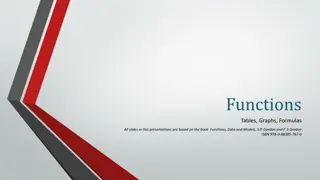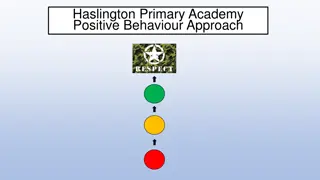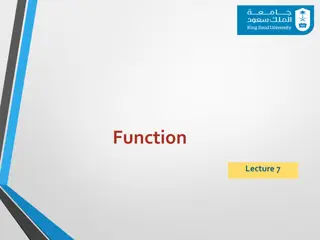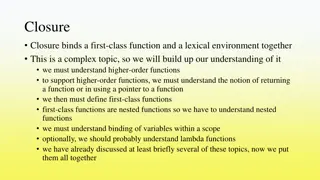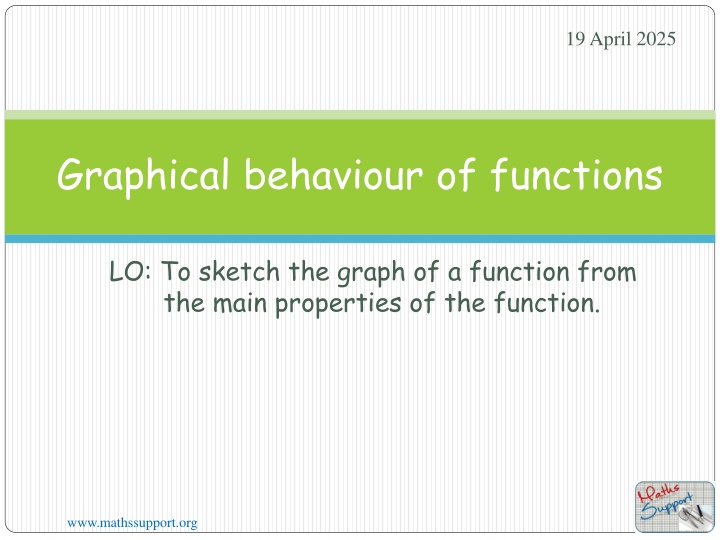
Graphical Behavior of Functions: Sketching Techniques & Derivatives
Learn how to sketch the graph of a function using first and second derivatives, critical numbers, concavity, inflection points, and intercepts. Discover the concepts of increasing and decreasing intervals in functions for effective graphing. Enhance your knowledge of graphical behavior through practical examples and step-by-step guides.
Download Presentation

Please find below an Image/Link to download the presentation.
The content on the website is provided AS IS for your information and personal use only. It may not be sold, licensed, or shared on other websites without obtaining consent from the author. If you encounter any issues during the download, it is possible that the publisher has removed the file from their server.
You are allowed to download the files provided on this website for personal or commercial use, subject to the condition that they are used lawfully. All files are the property of their respective owners.
The content on the website is provided AS IS for your information and personal use only. It may not be sold, licensed, or shared on other websites without obtaining consent from the author.
E N D
Presentation Transcript
19 April 2025 Graphical behaviour of functions LO: To sketch the graph of a function from the main properties of the function. www.mathssupport.org
First and second derivatives The first and second derivatives of a function tell us much about the graph of the function. With the first derivative: We know the critical numbers. If the graph is increasing If the graph is decreasing If there is a relative maximum If there is a relative minimum If there is a point where f (x) is undefined www.mathssupport.org
First and second derivatives The first and second derivatives of a function tell us much about the graph of the function. With the second derivative: We know the concavity of the graph. If the graph is concave up If the graph is concave down If there are points of inflection We can also use intercepts and asymptotes to help to complete the graph. www.mathssupport.org
Sketching a graph Use the first and second derivatives, intercepts, asymptotes to sketch the graph of the function f(x) = 2x3 3x2 12x In order to sketch the graph we need this information: Increasing: y Decreasing : 10 Relative maximum: 5 Relative minimum: 0 x 1 2 3 5 -4 -3 -2 -1 4 -5 Concave down: -5 Concave up: -10 -15 Inflection point: -20 x-intercepts: y-intercept: www.mathssupport.org
Increasing and decreasing intervals Find the intervals on which f(x) = 2x3 3x2 12x is increasing or decreasing. f (x) = 6x2 6x 12 6x2 6x 12 = 0 6(x2 x 2) = 0 6(x 2)(x + 1) = 0 The critical numbers are x = 2 Find the first derivative of f Find the critical numbers where f (x) = 0 x = 1 + - + Make a sign diagram for f (x) 2 -3 -2 1 0 -1 3 Evaluate the derivative in the three intervals f ( 2) = 24 positive f (3) = 24 f (0) = 12 negative positive fis increasing on ( , 1) and (2, ) since f (x) > 0 fis decreasing on ( 1. 2) since f (x) < 0 www.mathssupport.org
Sketching a graph Use the first and second derivatives, intercepts, asymptotes to sketch the graph of the function f(x) = 2x3 3x2 12x In order to sketch the graph we need this information: (- , 1) (-1, 2) (2, ) and Increasing: y Decreasing : 10 Relative maximum: 5 Relative minimum: 0 x 1 2 3 5 -4 -3 -2 -1 4 -5 Concave down: -5 Concave up: -10 -15 Inflection point: -20 x-intercepts: Increasing Increasing Decreasing y-intercept: www.mathssupport.org
Relative maximum and minimum Find the relative extrema for the function f(x) = 2x3 3x2 12x. f (x) = 6x2 6x - 12 Find the derivative of f 6x2 6x 12 = 0 Find the critical numbers of f by making f (x)= 0 6(x 2)(x + 1) = 0 x = 2 or x = 1 + - + Use the sign diagram for f 2 -1 Sincef (x) changes from positive to negative at x = -1 there is a relative maximum atx= 1 Sincef (x) changes from negative to positive at x = 2 there is a relative minimum at x= 2 f(-1) = 2(-1)3 3(-1)2 - 12(-1) Evaluate f(x) for the critical numbers Relative maximum point is (-1, 7) f (-2) = 24 f (0) = -12 f (3) = 24 Evaluate f (x) to determine the signs f (-2) = 6(-2)2 6(-3) - 12 f (0) = 6(0)2 6(0) - 12 f (3) = 6(3)2 6(3) - 12 f(-1) = 7 f(2) = -20 f(2) = 2(2)3 3(2)2 - 12(2) Relative minimum point is (2, -20) www.mathssupport.org
Sketching a graph Use the first and second derivatives, intercepts, asymptotes to sketch the graph of the function f(x) = 2x3 3x2 12x In order to sketch the graph we need this information: (- , 1) and(2, ) (-1, 2) (-1, 7) (2, -20) Increasing: y Decreasing : 10 Relative maximum Relative maximum: 5 Relative minimum: 0 x 1 2 3 5 -4 -3 -2 -1 4 -5 Concave down: -5 Concave up: -10 -15 Inflection point: -20 Relative minimum x-intercepts: Increasing Increasing Decreasing y-intercept: www.mathssupport.org
Concavity Find the intervals where the function f(x) = 2x3 3x2 12x is concave up and concave down. Find the inflection points. Find the second derivative of f f (x) = 12x 6 f (x) = 6x2 6x 12 x = 1 0 = 12x 6 - Find where f (x)= 0 2 + Make a sign diagram for f 1 2 2 since f (x) < 0 f (0) = 12(0)2 6 f (1) = 12(1)2 6 1 2, since f (x) > 0 f is concave down on ,1 Evaluate f (x) to determine the signs f is concave up on Since f (x) changes the sign at x = 1 point there f (0) = 6 f (1) = 6 2 there is an inflection 3 3 2 12 = 13 1 2 = 2 1 2 1 2 1 2 Evaluate f at x = 1 of the inflection point f 2to find the y-coordinate 2 1 2, 13 So, the inflection point is 2 www.mathssupport.org
Sketching a graph Use the first and second derivatives, intercepts, asymptotes to sketch the graph of the function f(x) = 2x3 3x2 12x In order to sketch the graph we need this information: (- , 1) and(2, ) (-1, 2) (-1, 7) (2, -20) ,1 Increasing: y Decreasing : 10 Relative maximum Relative maximum: 5 Relative minimum: 0 x 1 2 3 5 -4 -3 -2 -1 4 -5 Concave down: -5 2 Point of inflection 1 2, 1 2, 13 Concave up: -10 -15 Inflection point: 2 -20 Relative minimum x-intercepts: Increasing Increasing Decreasing Concave down: Concave up: y-intercept: www.mathssupport.org
Concavity Find the y-intercept and x-intercepts of the function f(x) = 2x3 3x2 12x. To find the x-intercepts equate to 0 and solve for x 2x3 3x2 12x = 0 x(2x2 3x 12) = 0 x = 0 (2x2 3x 12) = 0 or Factorising 2 4 b b 2 a c Using the quadratic formula to find x = x a 3 (-3)2 (4 2 -12) x = 2 2 x = -1.81 x = 3.31 (0, 0) (-1.81, 0) (3.31, 0) (0, 0) So, y-intercept x-intercepts www.mathssupport.org
Sketching a graph Use the first and second derivatives, intercepts, asymptotes to sketch the graph of the function f(x) = 2x3 3x2 12x In order to sketch the graph we need this information: (- , 1) and(2, ) (-1, 2) (-1, 7) (2, -20) ,1 Increasing: y Decreasing : 10 Relative maximum Relative maximum: 5 Relative minimum: 0 x 1 2 3 5 -4 -3 -2 -1 4 -5 Concave down: -5 2 Point of inflection 1 2, 1 2, 13 Concave up: -10 -15 Inflection point: 2 -20 Relative minimum (0, 0)(-1.8, 0) (3.31, 0) x-intercepts: Increasing Increasing Decreasing (0, 0) Concave down: Concave up: y-intercept: www.mathssupport.org
Relationship between the graphs of f, f and f www.mathssupport.org
Given that the graph shown is a graph of f, sketch the graphs of f and f The graph changes from decreasing to increasing and has a relative minimum at x= 3 y 10 This means that f (x) equals zero at x= 3 And changes from negative to positive. 9 f (x) 8 7 6 5 4 f (x) 3 The graph of f is always concave up. This means that f (x) is always positive. Since f (x) is the derivative of f (x), a linear function, f (x) must be a positive constant. 2 1 -10 1 2 3 4 5 6 7 9 10 -9 -8 -7 -6 -5 -4 -3 -2 8 -1 x 0 -1 -2 -3 -4 -5 -6 f (x) -7 -8 -9 www.mathssupport.org
Given that the graph shown is a graph of f , sketch the graphs of f and f Since f equals zero when x= -1 and changes from positive to negative, the graph of f has a relative maximum when x= -1 Since f (x) equals zero when x= 7 and changes from negative to positive the graph of f has a relative minimum when x= 7 . Since f (x) has a relative minimum when x= 3 the graph of f (x) equals zero when x= 3 Sincef (x) is concave down for x<3f (x) is negative for x<3 Sincef (x) is concave up for x>3f (x) is positive for x>3 y 10 9 8 f (x) 7 6 5 4 3 2 1 -10 1 2 3 4 5 6 7 9 10 -9 -8 -7 -6 -5 -4 -3 -2 8 -1 x 0 -1 -2 -3 -4 f (x) -5 -6 f (x) -7 -8 -9 www.mathssupport.org
Thank you for using resources from A close up of a cage Description automatically generated For more resources visit our website https://www.mathssupport.org If you have a special request, drop us an email info@mathssupport.org www.mathssupport.org






